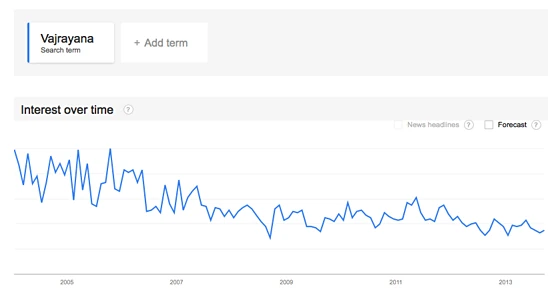In my post Diclofenac warning for tantrikas I wrote:
Vultures are not afraid of death. They thrive on it. But they are in serious danger of extinction.

Sometimes I wonder if that is also true of tantrikas.
I had conversations with older practitioners which led me to believe Vajryana was more sought during the 1960s to 1990s than it is now. Does Vajrayana appeal less to contemporaries than it did to the hippy generation explorers and young people 40 years ago? If so, does this matter?
In the 1960s through 1970s there was a surge in the introduction of Buddhisms to the West. The baby boom generation travelled to Asia and brought back with them more teachers and Buddhist practices. It sounds like it was an exciting time, encountering differences and expanding personal and cultural horizons.
Vajrayana played a part in that encounter, usually as part of a larger package of Tibetan Buddhism. Accomplished Tibetan masters, such as Namkhai Norbu Rinpoche and Chögyam Trungpa Rinpoche left Tibet and began to set up institutional structures to train Western students in the 1960s. Young American and European students sought teachings and retreat in India and returned empowered to take their own students.
There was, then, a cultural excitement with the exotic in a way that doesn’t exist now. I think that Vajrayana, as practiced by Tibetans (which is the form I know best) would have fit well into that particular exchange. Its loud instruments, formal rituals, and paintings of colourful, ferocious-looking beings would have seemed attractively way-out. Cultural unfamiliarity appealed for its own sake.
East-West cultural distance, taken as given for much of the 20th century, does not exist now in the way it did in the 1960s when many of the forms of Buddhism available today were established in the West. Today, it is normal to choose between different cultural forms, according to personal preference. Additionally, a popular liberal Western value rejects formal religious ritual as unnecessary and superfluous.1
How would we even know?
How might we know that tantrikas are in danger of extinction? To begin, we should assess whether Vajrayana is waning in terms of interest and availability.
As far as I know, there are no numbers available for Vajrayana students since 1960 to the present day, so no obvious means of quantitative assessment. One could look at numbers of Vajrayana teachers: that might be feasible – though that would not indicate numbers of students and their degree of involvement.
Maybe quantity is not important with regards to continuity. You might say that what matters is only that there remain a few high quality teachers to pass Vajrayana on to some capable students, who in their turn will transmit the lineages. Then continuity is most important for its own sake and a limited minority. Numbers don’t matter in this view. This is an argument I have heard most frequently inside traditional Vajrayana circles.
If you care about Vajrayana’s continuity for its own sake, or for small numbers, then all you are likely to care about is that each teacher transmits their lineage to at least one or two in the next generation. Proponents of this view tend not to worry too much about cultural adaptation. They emphasize maintenance of the status quo. This is a coherent position, but its self-referentiality is blind to the risk of extinction from competition.
If you care about Vajrayana’s potential impact in contemporary society, as I do, then quantity of teachers and committed students do matter. Anecdotally, it seems that intelligent, highly motivated, enthusiastic practitioners recognize that Vajrayana-derived practices are functionally distinct to Western psychology, therapy, other forms of Buddhism, and other spiritual systems. They want and would benefit from access to styles of Vajrayana that don’t yet exist. This year’s (2013) Buddhist Geeks conference confirmed that. I don’t think anyone is wrong for wanting new forms of Vajrayana, or that it is an unrealistic proposal. Enthusiasm for creativity and change is Tantric in style.
Does this interest impact general trends significantly? It seems unlikely. Vajrayana is niche.
This is a screenshot of the Google search trend for ‘Vajrayana.’ Unfortunately, data is only available since 2004. The graph shows a gradual, fairly steady 60% decline since May 2004. [The downward trend has continued since I wrote this post. May 2018 marks a 70% drop in ‘Vajrayana’ used in search term queries, since May 2004.]

More data is available for ‘Vajrayana’ mentioned in books:

There is a steep downward trend after 2000. There is no data for 2008 to 2013, but if we assume the same rate of decline as for the previous 8 years, as indicated by the search term trend, we’ve already reached 0.
This kind of data is general and limited, but it’s the best available for this post.
The search data suggests a general decline in interest and there is anecdotal evidence that people interested can’t find fitting forms.
What do you think this suggests? How would you interpret the data? I will visit the question again in future posts, but I’d like to hear from you first.
Questions to readers:
Do you think tantrikas are in danger of extinction? Why, or why not?
What other data, quantitative or qualitative, might we take into account?
My analysis that needs are unmet is anecdotal. Is it accurate?
What do you think are the implications of declining interest, possibly alongside unmet need: for teachers, sanghas and seekers?
- 1.Romanticizing and disdaining cultural otherness are two sides of the same Orientalist coin.
